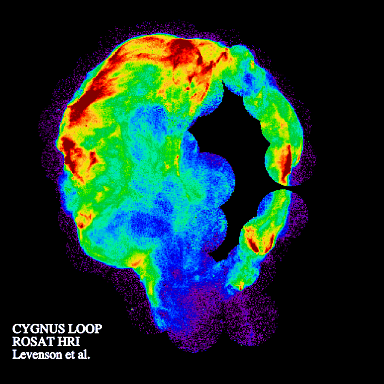Cygnus Loop - HRI Image (Credit: Levenson et.al) This supernova remnant in the constellation Cygnus, known as the Cygnus Loop, is roughly 20,000 years old. It is generally circular in shape except for a break-out towards the south. In addition, there are many bright, filamentary structures. The HRI image shows the angular structure of the Cygnus Loop. Even with this image some of the fine-scale structure is not resolved (both because of the coarse angular binning and through insufficient event statistics). The High Resolution Imager (HRI, a microchannel plated detector) is one of two instruments that flew on ROSAT. It has a minimum psf of 5 arc seconds (the angular resolution for both detectors degraded off axis because of the mirror response). On the other hand, the PSPC had limited energy resolution (E/delta E ~1-2) allowing spectral fits and multiband photometry while the HRI has essentially no energy resolution. Thus, the two detectors were complimentary with the PSPC providing the best spectral information and the HRI providing the best angular resolution. A proportional counter is essentially a gas-filled box with a thin window on one side and high-voltage wires running through it. A photon enters through the window and ionizes an atom of the gas producing an electron with most of the energy of the photon. This primary electron ionizes additional atoms and produces a cloud of secondary electrons, the number of which is roughly proportional to the energy of the incident photon (thus the name). This cloud of electrons drifts toward the high-voltage wires (anodes) and when the electrons are near enough to the wires, the energy they gain between collisions with atoms of the gas is sufficient to ionize the next atom that they hit. This produces an electron cascade (a controlled breakdown) which is detected as a charge pulse, amplified, and digitized to give an estimate for the energy of the photon. A positive pulse is induced on additional wires in the detector (crossed cathodes) which allows a position determination. The ROSAT HRI is comprised of two cascaded microchannel plates (MCPs) with a crossed grid position readout system. A microchannel plate is a glass plate with many parallel channels (holes) running through it and a voltage applied across it. The holes are typically ~10 microns wide. Photons enter a channel and photoionize an atom in the wall. With the applied voltage, the channel then acts as a small photomultiplier tube producing a final charge pulse which is detected. Get the high resolution (200 dpi) TIFF format version
IMAGES |
By Mission |
Stars |
HEASARC Home | Observatories | Archive | Calibration | Software | Tools | Students/Teachers/Public Last modified: Thursday, 26-Jun-2003 13:48:44 EDT |

